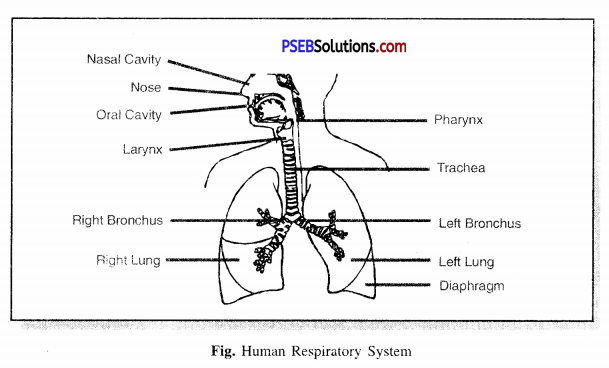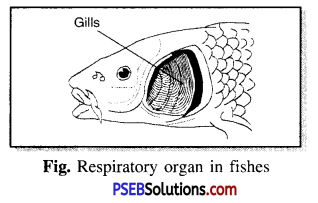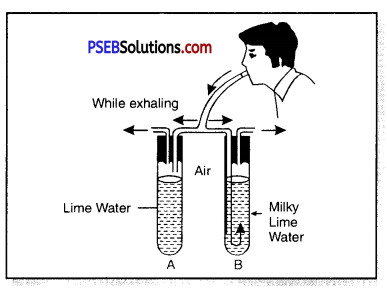Punjab State Board PSEB 7th Class Science Book Solutions Chapter 10 Respiration in Organisms Textbook Exercise Questions and Answers.
PSEB Solutions for Class 7 Science Chapter 10 Respiration in Organisms
Science Guide for Class 7 PSEB Respiration in Organisms Intext Questions and Answers
Think and Answer (Textbook Page No. 117)
Question 1.
How long were you able to hold your breath?
Answer:
Up to 35 seconds.
Question 2.
Why can we not hold our breath for a long time?
Answer:
We need oxygen all the time within our body, by holding breath for too long the amount of Carbon dioxide will increase which can be fatal.
![]()
Think and answer (Textbook Page No. 118)
Question 1.
In which condition the rate of breathing is slowest ?
Answer:
After resting, the respiratory rate is at least 12 to 20 breaths per minute. A lower rate is a sign of a physical problem.
Question 2.
What is your normal breathing rate ?
Answer:
20 breaths per minute.
Think and Answer (Textbook Page No. 121)
Question 1.
What does the rubber sheet represent ?
Answer:
The Diaphragm represents the rubber seat.
Question 2.
Which organs are represented by balloons ?
Answer:
The two lungs represent the balloons.
Question 3.
Can you explain the mechanism of breathing with the help of this model ?
Answer:
Yes, because it is working model of breathing. Therefore, this will explain that action completely.
Think and Answer (Textbook Page No. 118)
Question 1.
Why does lime water turn milky ?
Answer:
When we blow in lime water the exhaled carbon dioxide reacts with lime water to make lime water milky.
Question 2.
What is the formula of lime water ?
Answer:
Chemical formula of Lime water: Ca(OH)2
![]()
PSEB 7th Class Science Guide Respiration in Organisms Textbook Questions and Answers
1. Fill in the Blanks:
(i) Lactic acid is produced during ………………….. respiration.
Answer:
Aerobic
(ii) Taking in of air rich in oxygen is called ………………… .
Answer:
Breathing
(iii) The number of times a person breathes in a minute is termed as ……………………. .
Answer:
Breathing rate
(iv) Exchange of gases in the leaves of plants takes place through ……………….. .
Answer:
Stomata
(v) The skin of an earthworm is …………….. to touch.
Answer:
Wet and slippery
2. State True or False:
(i) Frogs breathe through their skin as well as lungs.
Answer:
True
(ii) We cannot feel breathing movements in our body.
Answer:
False
(iii) Aerobic respiration produces more energy than anaerobic respiration.
Answer:
True
![]()
(iv) During heavy exercise the breathing rate of a person slows down.
Answer:
True
(v) Insects have organ, called trachea for respiration.
Answer:
True
3. Match the Column ‘A’ with Column ‘B’:
| Column ‘A’ | Column ‘B’ |
| (i) Lenticels | (a) Gills |
| (ii) Yeast | (b) Old stem |
| (iii) Fish | (c) Skin |
| (iv) Stomata | (d) Alcohol |
| (v) Earthworm | (e) Leaves |
Answer:
| Column ‘A’ | Column ‘B’ |
| (i) Lenticels | (b) Old stem |
| (ii) Yeast | (d) Alcohol |
| (iii) Fish | (a) Gills |
| (iv) Stomata | (e) Leaves |
| (v) Earthworm | (c) Skin |
4. Choose the Correct Answer:
Question (i)
The earthworms respire through:
(a) Trachea
(b) Gills
(c) Lungs
(d) Skin.
Answer:
(d) Skin
Question (ii)
Respiration helps in:
(a) Digestion
(b) Energy production
(c) Locomotion
(d) Chromosomes.
Answer:
(b) Energy production.
Question (iii)
In cockroaches, air enters the body through:
(a) Skin
(b) Lungs
(c) Spiracles
(d) Gills.
Answer:
(c) Spiracles.
Question (iv)
In old and woody stem gaseous exchange take place through:
(a) Stomata
(b) Lenticels
(c) Root hair
(d) Do not respire.
Answer:
(b) Lenticels.
![]()
Question (v)
During heavy exercise we get cramps due to:
(a) Glucose
(b) Oxygen
(c) Lactic acid
(d) Alcohol.
Answer:
(c) Lactic acid.
5. Very Short Answer Type Questions:
Question (i)
Define the term breathing rate.
Answer:
Breathing Rate. The number of times a person breathes in a minute, is called the breathing rate. Breathing once means inhaling once and exhaling once.
Question (ii)
What is respiration ? Name two types of respiration.
Answer:
Respiration. This is a simple physical activity during which oxygen-rich air from the atmosphere is drawn into the respiratory organs (lungs in humans). This part of the respiratory system is called breathing and after breathing, carbon dioxide-rich air is expelled from the respiratory tract into the atmosphere.
There are two types of respirations:
- Aerobic respiration.
- Anaerobic respiration.
6. Short Answer Type Questions:
Question (i)
Why do we get muscle cramps after heavy excercise ?
Answer:
After exercise we feel tired due to Anaerobic respiration. In the absence of oxygen, lactic acid is formed due to the partial oxidation of glucose. Lactic acid builds up in the muscles causing fatigue and stiffness.
Question (ii)
Why does an over watered potted plant die ?
Answer:
When we water the plants more than what plants need, they die. This is because more water fills the air spaces between the soil particles. As a result, the roots of the plants do not get enough oxygen.
Question (iii)
Why do we often sneeze when we inhale a lot of dust-laden air ?
Answer:
When we inhale in a dusty environment, the unwanted dust particles get trapped in the nasal passage, nasal hair and mucus causing irritation or itching in the nose which makes us sneeze. With the onset of sneezing, those unnecessary dust particles are expelled and clean air begins to enter our lungs.
7. Long Answer Type Questions:
Question (i)
How respiration is different from breathing ?
Answer:
Differences between Respiratory and Breathing.
| Respiration | Breathing |
| (1) This action takes place in cells. | (1) This action takes place outside the cells. |
| (2) Energy is produced in this action. | (2) This action does not produce energy. |
| (3) It is a chemical reaction. | (3) It is a physical activity in which gases are exchanged. |
| (4) Respiratory organs are not required in this activity. | (4) The respiratory organs (lungs) are required. |
| (5) It requires enzymes. | (5) Enzymes are not required in this activity. |
| (6) This action produces carbon dioxide and energy. | (6) It releases carbon dioxide. |
| (7) It involves oxidation of glucose. | (7) It draws in oxygen. |
![]()
Question (ii)
Draw a labelled diagram of human respiratory system.
Answer:
Labelled diagram of human Respiratory System:

Question (iii)
List similarities and differences between aerobic and anaerobic respiration.
Answer:
Difference between Aerobic respiration and Anaerobic respiration :
| Aerobic Respiration | Anaerobic Respiration |
| (1) This action occurs in the presence of oxygen. | (1) This action takes place in the absence of oxygen. |
| (2) This action takes place in both the biological fluid and the mitochondria biological fluid. | (2) This action takes place only in the of the cells. |
| (3) In aerobic respiration, complete oxidation of glucose occurs. | (3) In anaerobic respiration incomplete oxidation of glucose takes place. |
| (4) In this action CO2 and water are formed. | (4) Alcohol and carbon dioxide are formed in this process. |
| (5) In this action from a molecule of glucose 38 ATP molecules are free. | (5) From a molecule of glucose in this action 2 ATP molecules are free. |
| (6) Complete oxidation of one molecule of glucose releases 673 kcal of energy. | (6) Partial oxidation of one molecule of glucose releasing 21 kilo calorie of energy. |
PSEB Solutions for Class 7 Science Respiration in Organisms Important Questions and Answers
1. Fill in the Blanks:
(i) Organisms that do not require oxygen for respiration are called ………………..
Answer:
Anaerobic organisms
(ii) Accumulation of ………………….. causes stiffness in muscles.
Answer:
Lactic acid
(iii) Our breathing rate ………………… when we do exercise or work hard.
Answer:
Increases
(iv) The leaves of plants use ……………….. for the exchange of gases.
Answer:
Stomata
(v) Fishes breathe through …………………..
Answer:
Gills
![]()
2. Match the Column ‘I’ with Column ‘II’:
| Column ‘I’ | Column ‘II’ |
| (a) Yeast | (i) Earthworm |
| (b) Diaphragm | (ii) Gills |
| (c) Skin | (iii) Alcohol |
| (d) Leaves | (iv) Chest Cavity |
| (e) Fish | (v) Stomata |
| (f) Frog | (vi) Lungs and skin |
Answer:
| Column ‘I’ | Column ‘II’ |
| (a) Yeast | (iii) Alcohol |
| (b) Diaphragm | (iv) Chest Cavity |
| (c) Skin | (i) Earthworm |
| (d) Leaves | (v) Stomata |
| (e) Fish | (vi) Gills |
| (f) Frog | (vii) Lungs and skin |
3. Choose the Correct Answer:
Question (i)
Which one of the following is an anaerobic organism ?
(a) Cow
(b) Yeast
(c) Frog
(d) Butterfly.
Answer:
(b) Yeast.
Question (ii)
The percentage of CO2 in exhaled air is:
(a) 0.4%
(b) 4%
(c) 4.4%
(d) 14.4%.
Answer:
(c) 4.4%.
Question (iii)
The products of anaerobic respiration are:
(a) Carbohydrate and O2
(b) Ethylalcohol and CO2
(c) Carbohydrate and CO2
(d) Ethylalcohol and O2
Answer:
(b) Ethylalcohol and CO2
Question (iv)
Respiratory organs of fish are:
(a) Skin
(b) Lungs
(c) Gills
(d) Stomata.
Answer:
(c) Gills.
Question (v)
Plants carry out photosynthesis only during:
(a) Night
(b) Day
(c) Day and Night
(d) None of these.
Answer:
(b) Day
Question (vi)
Respiratory organs of frog are:
(a) Lungs and Skin
(b) Gills
(c) Only skin
(d) None of these.
Answer:
(a) Lungs and Skin.
![]()
Question (vii)
The Vital biological system of organisms is:
(a) Digestion
(b) Reproduction
(c) Excretion
(d) Respiration.
Answer:
(d) Respiration.
Question (viii)
Which organism uses more than one organ for respiration?
(a) Fish
(b) Cockroach
(c) Human
(d) Frog.
Answer:
(d) Frog.
Question (ix)
Air enters ¡n the body of cockroach:
(a) Through lungs
(b) Through gilds
(e) Through spricales
(d) Through skin.
Answer:
(e) Through spricals.
4. State True or False:
(i) During heavy exercise the breathing rate of a person slows down.
Answer:
False
(ii) Plants carry out photosynthesis only during the day and respiration only at night.
Answer:
False
(iii) Frogs breathe through their apart from skin.
Answer:
True
(iv) The fishes have lungs for respiration.
Answer:
False
(v) The size of the chest cavity increases during inhalation.
Answer:
True
![]()
Very Short Answer Type Qucstions
Question 1.
Name the energy giving processes.
Answer:
Nutrition and respiration.
Question 2.
What are the end products of aerobic respiration ?
Answer:
Carbon dioxide, water and energy.
Question 3.
What are the end products of anaerobic respiration ?
Answer:
Ethyl alcohol (C2H5OH) and carbon dioxide (CO2).
Question 4.
Define breathing.
Answer:
Breathing. The process by which organisms take oxygen from environment and release carbon dioxide, is called breathing.
Question 5.
What are the two main processes in respiration ?
Answer:
The two main processes in respiration are:
(i) Breathing i.e. taking in O2 and giving out CO2.
(ii) Using O2 in the cells (internal respiration).
Question 6.
What are anaerobes ?
Answer:
Anaerobes. Organisms which can survive in absence of free air are called anaerobes.
Question 7.
Give an example of anaerobe.
Answer:
Yeast.
![]()
Question 8.
What is cellular respiration ?
Answer:
Cellular respiration. Respiration taking place in living cells is called cellular respiration.
Question 9.
Which functions of cell need energy ?
Answer:
Nutrition, transport, excretion, reproduction.
Question 10.
What is the reason of cramps in legs ?
Answer:
Formation of lactic acid.
Question 11.
How can the muscles of legs be relieved ?
Answer:
By massaging or taking hot water bath.
Question 12.
When does breathing rate increase ?
Answer:
During exercise or running.
Question 13.
What is diaphragm ?
Answer:
Diaphragm. It is a large muscular sheet forming the floor of chest cavity.
Question 14.
What happens to chest cavity during inhalation ?
Answer:
During inhalation, the space in chest cavity increases.
Question 15.
When does the space in chest cavity decrease ?
Answer:
During exhalation.
Short Answer Type Questions
Question 1.
What is anaerobic respiration ?
Answer:
Anaerobic respiration. Some cells like bacteria and yeast release energy by breaking down glucose into ethyl alcohol and CO2 in the absence of oxygen. This process is called anaerobic respiration.
![]()
Question 2.
What are stomata ? Give two functions of stomata.
Answer:
Stomata. These are the small holes (pores) present on the lower surface of leaves. It is guarded by two kidney-shaped guard cells. The light affects its opening.
Functions. (i) Exchange of gases, (ii) Control of transpiration.
Question 3.
Explain respiration in plants.
Answer:
Respiration in plants. Plants, during the process of photosynthesis, give off oxygen which is utilized during respiration.
Stomata are the openings located on the lower surface of the leaves which are guarded by two kidney-shaped guard cells. Through stomatal opening exchange of gases takes place.
Question 4.
Is respiration the same as breathing ?
Answer:
Resiration and breathing are not the same processes. During respiration oxidation of food occurs along with the release of energy. It is purely a chemical process. Breathing is purely a physical process. It mainly occurs by inhalation and exhalation. In breathing simply exchange of gases occurs, where O2 is drawn in and carbon dioxide is thrown out.
Question 5.
Give chemical equation for Aerobic respiration.
Answer:
Glucose + Oxygen → Carbon dioxide + Water + energy.
C6H12O6 + 6O2 → 6CO2 + 6H2O + Energy
Question 6.
Give an account of movement of ribs during inhalation and exhalation processes.
Answer:
Movement of Ribs
- During inhalation. Ribs move up and outwards to increase space in chest cavity.
- During exhalation. Ribs move down and inwards to decrease space in chest cavity.
Question 7.
Describe the importance of respiration in plants. .
Answer:
Importance of respiration in plants. During respiration the energy rich foodstuffs (glucose and fructose) are changed into water and carbon dioxide accompanied by the release of usable energy which is necessary for the sustenance of plant life. The carbon dioxide so released is made use of in the manufacture of food by the plant during the process of photosynthesis.
Question 8.
Give an account of respiration in fishes.
Answer:
Respiration in fishes. Fishes live in water and breathe through gills which is their breathing organ. Fishes take in water through their mouth and force is out through the gills. In gills water and blood flow in opposite direction to increase diffusion of oxygen.

Long Answer Type Question
Question 1.
Show by an experiment that CO2 is present in the exhaled air.
Answer:

We can prove by the following experiment that CO2 is present in the exhaled air:
Experiment. Set up the apparatus as shown in the figure. Exhale air through your mouth into the tube provided for this purpose. You will notice that the lime water is kept in test B. Through which exhaled air is passing has turned milky.
On the other hand, test tube A through which exhaled air is not passing has shown slight milkiness due to atmosphere air entering from the side tube. It proves that carbon dioxide is present in exhaled air which has turned lime water present in test tube B milky and milkiness is due to the formation of calcium carbonate in the figure.

